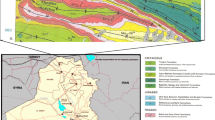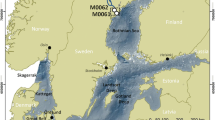Abstract
A series of individual turbidites, correlated over distances >100 km, are present in the recent fill of the Agadir Basin, offshore northwest Africa. The aim here is to unravel multiple turbidite source areas and flow pathways, and show how turbidite provenance studies contribute to interpretation of flow processes. Agadir Basin turbidites are sourced from four main areas, with the majority originating from the siliciclastic Morocco Shelf; their sand-mud distribution is strongly controlled by flow sediment volume, with relatively low-volume flows dying out within the Agadir Basin and large-volume flows bypassing significant sediment volumes to basins further downslope. Two large-volume volcaniclastic turbidites are attributed to a Canary Islands landslide source, while several small mud-dominated turbidites are interpreted to be locally sourced from hemipelagic-draped seamounts (e.g. Turbidite AB10). Finally, Turbidite AB1 (∼1 ka) is only present in the western Agadir Basin, and is linked to recent “re-activation” of the Sahara Slide headwall. The muddy suspension clouds of three large-volume flows, all linked to large-scale landslides, have covered huge areas of seafloor and flowed along or even slightly upslope for long distances. It is proposed that northeastwards-flowing bottom currents have aided transport of these dilute flow fractions into and across the Agadir Basin.









Similar content being viewed by others
References
Baumann K-H, Boeckel B, Donner B, Gerhardt S, Henrich R, Vink A, Volbers A, Willems H, Zonneveld KAF (2004) Contribution of calcareous plankton groups to the carbonate budget of South Atlantic surface sediments. In: Wefer G, Mulitza S, Ratmeyer V (eds) The South Atlantic in the Late Quaternary; reconstruction of material budget and current systems. Springer, Berlin, pp 81–99
Carracedo JC (1999) Growth, structure, instability and collapse of Canarian volcanoes and comparisons with Hawaiian volcanoes. J Volcanol Geotherm Res 94:1–19
Carracedo JC, Pérez Torrado FJ, Ancochea E, Joaquín M, Hernán F, Cubas CR, Casillas R, Rodríguez Badiola E, Ahilado A (2002) Cenozoic volcanism II: the Canary Islands. In: Gibbons W, Moreno T (eds) The geology of Spain. The Geological Society, London, pp 439–472
Croudace IW, Rindby A, Rothwell RG (2006) ITRAX: description and evaluation of a new multi-function X-ray core scanner. In: Rothwell RG (ed) New techniques in sediment core analysis. Geological Society London, Special Publication 267, pp 51–63
Davies TL, van Niel B, Kidd RB, Weaver PPE (1997) High-resolution stratigraphy and turbidite processes in the Seine Abyssal Plain, northwest Africa. Geomar Lett 17:147–153
de Lange GJ, Jarvis I, Kuijpers A (1987) Geochemical characteristics and provenance of late Quaternary sediments from the Madeira Abyssal Plain, N Atlantic. In: Weaver PPE, Thomson J (eds) Geology and geochemistry of Abyssal Plains. Blackwell, Oxford, pp 147–165
Georgiopoulou A (2006) Turbidity currents and the giant Sahara Slide, Northwest African margin: triggers, flow processes and deposits. PhD thesis, University of Southampton, Southampton, p 188
Gerhardt S, Henrich R (2001) Shell preservation of Limacina inflata (Pteropoda) in surface sediments from the Central and South Atlantic Ocean: a new proxy to determine the aragonite saturation state of water masses. Deep Sea Res I 48:2051–2071
Holcomb RT, Searle RC (1991) Large landslides from oceanic volcanoes. Mar Geotechnol 10:19–32
Jarvis I, Higgs N (1987) Trace-element mobility during early diagenesis in distal turbidites: late Quaternary of the Madeira Abyssal Plain, N. Atlantic. In: Weaver PPE, Thomson J (eds) Geology and geochemistry of Abyssal Plains. Blackwell, Oxford, pp 179–213
Lonsdale PF (1982) Sediment drifts of the Northeast Atlantic and their relationship to the observed abyssal currents. Bulletin Institute de Geologie Bassin d’Aquitaine, Bordeaux 31:141–150
Masson DG (1994) Late Quaternary turbidity current pathways to the Madeira Abyssal Plain and some constraints on turbidity current mechanisms. Basin Res 6:17–33
Masson DG (1996) Catastrophic collapse of the volcanic island of El Hierro 15 ka ago and the history of landslides in the Canary Islands. Geology 24:231–234
Masson DG, Canals M, Alonso B, Urgeles R, Hühnerbach V (1998) The Canary debris flow: source area morphology and failure mechanism. Sedimentology 45:411–432
Masson DG, Watts AB, Gee MRJ, Urgeles R, Mitchell NC, Le Bas TP, Canals M (2002) Slope failures on the flanks of the western Canary Islands. Earth Sci Rev 57:1–35
Masson DG, Harbitz CB, Wynn RB, Pedersen G, Løvholt F (2006) Submarine landslides—process, triggers and hazard prediction. Philos Trans R Soc Lond 364:2009–2039
Pearce TJ, Jarvis I (1992) Composition and provenance of turbidite sands: Late Quaternary, Madeira Abyssal Plain. Mar Geol 109:21–51
Pearce TJ, Jarvis I (1995) High-resolution chemostratigraphy of Quaternary distal turbidites: a case study of new methods for the analysis and correlation of barren sequences. In: Dunay RE, Hailwood EA (eds) Non-biostratigraphical methods of dating and correlation. Geological Society London, Special Publication 89, pp 107–143
Pilkey OH (1987) Sedimentology of basin plain. In: Weaver PPE, Thomson J (eds) Geology and geochemistry of Abyssal Plains. Geological Society London, Special Publication 31, pp 1–12
Rebesco M, Larter RD, Camerlenghi A, Barker PF (1996) Giant sediment drifts on the continental rise west of the Antarctic Peninsula. Geomar Lett 16:65–75
Rothwell RG, Hoogakker B, Thomson J, Croudace IW, Frenz M (2006) Turbidite emplacement on the southern Balearic Abyssal Plain (Western Mediterranean Sea) during Marine Isotope Stages 1–3: an application of ITRAX XRF scanning of sediment cores to lithostratigraphic analysis. In: Rothwell RG (ed) New techniques in sediment core analysis. Geological Society London, Special Publication 267, pp 79–89
Skoog DA, Holler FJ, Nieman TA (1998) Principles of Instrumental Analysis. Brooks & Cole, Florida, p 832
Talling PJ, Amy LA, Wynn RB, Peakall J, Robinson M (2004) Beds comprising debrite sandwiched within cogenetic turbidite: origin and widespread occurrence in distal depositional environments. Sedimentology 51:163–194
Talling PJ, Wynn RB, Masson DG, Frenz M, Cronin BT, Schiebel R, Akhmetzhanov AM, Dallmeier-Tiessen S, Bennetti S, Weaver PPE, Georgiopoulou A, Zühlsdorff C, Amy LA (2007) Onset of submarine debris flow deposition far from original giant landslide. Nature 450:541–544
Thomson J, Weaver PPE (1994) An AMS radiocarbon method to determine the emplacement time of recent deep-sea turbidites. Sediment Geol 89:1–7
Urgeles R, Canals M, Baraza J, Alonso B, Masson DG (1997) The most recent megaslides on the Canary Islands: the El Golfo debris avalanche and the Canary debris flow north-west El Hierro island. J Geophys Res 102:20305–20323
Wagner T (2002) Late Cretaceous to early Quaternary organic sedimentation in the eastern Equatorial Atlantic. Palaeogeogr Palaeoclimatol Palaeoecol 179:113–147
Watts AB, Masson DG (1995) A giant landslide on the north flank of Tenerife, Canary Islands. J Geophys Res 100:24487–24498
Weaver PPE, Kuijpers A (1983) Climatic control of turbidite deposition on the Madeira Abyssal Plain. Nature 306:360–363
Weaver PPE, Rothwell RG (1987) Sedimentation on the Madeira Abyssal Plain over the last 300,000 years. In: Weaver PPE, Thomson J (eds) Geology and geochemistry of Abyssal Plains. Blackwell, Oxford, pp 71–86
Weaver PPE, Rothwell RG, Ebbing J, Gunn D, Hunter PM (1992) Correlation, frequency of emplacement and source directions of megaturbidites on the Madeira Abyssal Plain. Mar Geol 109:1–20
Wynn RB, Masson DG (2003) Canary Islands landslides and tsunami generation. In: Mienert J and Locat J (eds) Proceedings 1st international symposium on submarine mass movements and their consequences, Kluwer, Dordrecht, pp 325–332
Wynn RB, Masson DG, Stow DAV, Weaver PPE (2000a) The Northwest African slope apron: a modern analogue for deep-water systems with complex seafloor topography. Mar Pet Geol 17:253–265
Wynn RB, Weaver PPE, Ercilla G, Stow DAV, Masson DG (2000b) Sedimentary processes in the Selvage sediment wave field, NE Atlantic: new insights into the formation of sediment waves beneath turbidity currents. Sedimentology 47:1181–1198
Wynn RB, Weaver PPE, Masson DG, Stow DAV (2002) Turbidite depositional architecture across three interconnected deep-water basins on the northwest African Margin. Sedimentology 49:669–695
Acknowledgments
This work was carried out within the EURODOM Research Training Network. We are grateful to NERC, ExxonMobil, BHP Billiton, ConocoPhillips, Shell and Norsk Hydro (now Statoil Hydro) for their financial support of the UK-TAPS Agadir Project. We would like to thank the Captains, Officers and crews of the various cruises involved in data collection. D. Green and B. Alker (NOCS), and C. Vogt and B. Kockisch (University of Bremen) are thanked for carrying out ICP, XRD and Leco analyses. S. Krastel (University of Bremen) kindly provided unpublished GLORIA data of the Dacia Seamount area. A. Akhmetzhanov (NOCS) provided invaluable seafloor maps generated from GEBCO bathymetry data. We thank the referees C. Pirmez and T. Hanebuth, and guest Editor M. Canals for their careful reviews that made the paper a much stronger contribution.
Author information
Authors and Affiliations
Corresponding author
Rights and permissions
About this article
Cite this article
Frenz, M., Wynn, R.B., Georgiopoulou, A. et al. Provenance and pathways of late Quaternary turbidites in the deep-water Agadir Basin, northwest African margin. Int J Earth Sci (Geol Rundsch) 98, 721–733 (2009). https://doi.org/10.1007/s00531-008-0313-4
Received:
Accepted:
Published:
Issue Date:
DOI: https://doi.org/10.1007/s00531-008-0313-4




